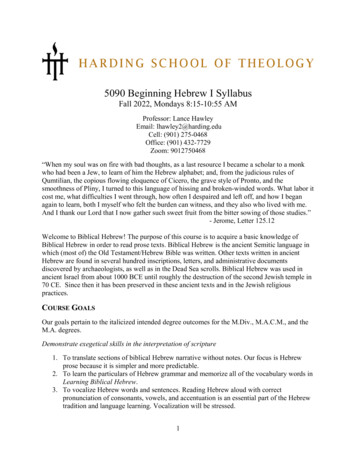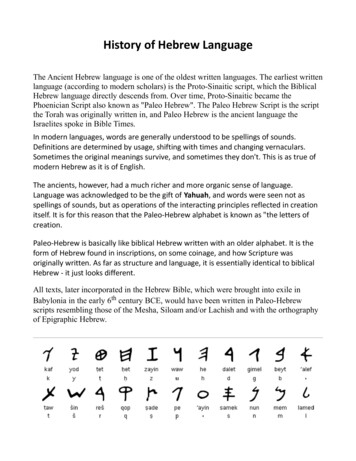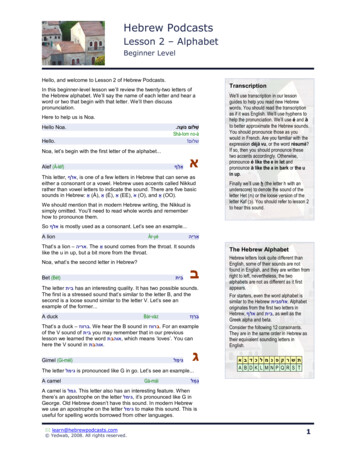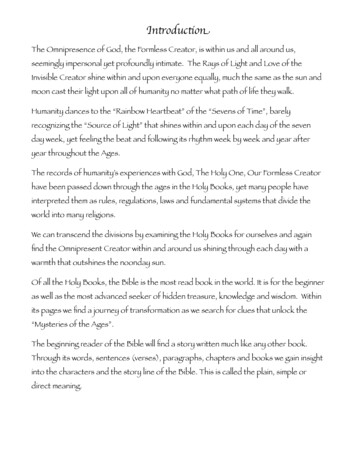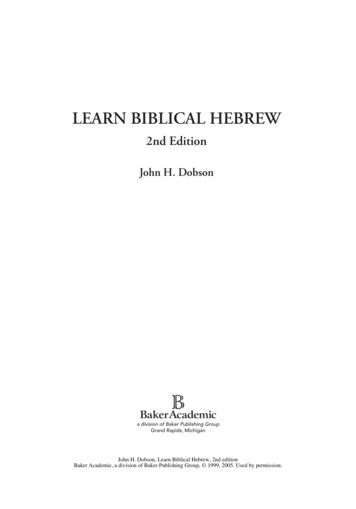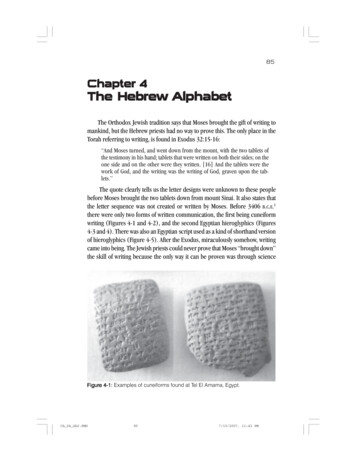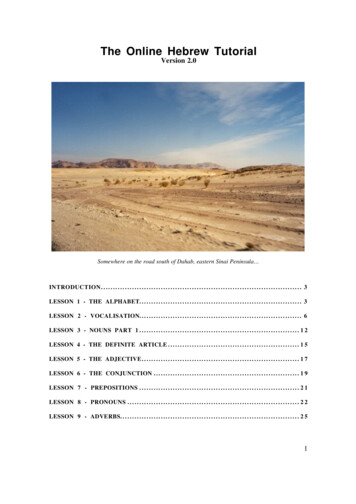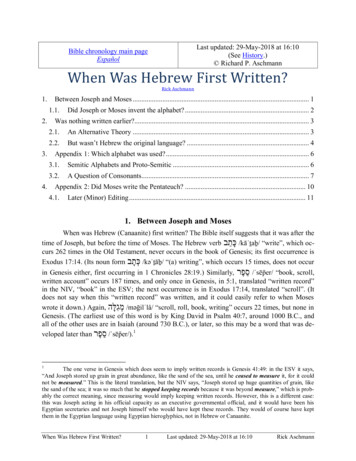
Transcription
Last updated: 29-May-2018 at 16:10(See History.) Richard P. AschmannBible chronology main pageEspañolWhen Was Hebrew First Written?Rick Aschmann1.Between Joseph and Moses . 11.1.2.3.4.Did Joseph or Moses invent the alphabet? . 2Was nothing written earlier?. 32.1.An Alternative Theory . 32.2.But wasn’t Hebrew the original language? . 4Appendix 1: Which alphabet was used? . 63.1.Semitic Alphabets and Proto-Semitic . 63.2.A Question of Consonants. 7Appendix 2: Did Moses write the Pentateuch? . 104.1.Later (Minor) Editing . 111. Between Joseph and MosesWhen was Hebrew (Canaanite) first written? The Bible itself suggests that it was after thetime of Joseph, but before the time of Moses. The Hebrew verb כָּתַ ב /kāˈṯaḇ/ “write”, which occurs 262 times in the Old Testament, never occurs in the book of Genesis; its first occurrence isExodus 17:14. (Its noun form כְּתָּ ב /kəˈṯāḇ/ “(a) writing”, which occurs 15 times, does not occurin Genesis either, first occurring in 1 Chronicles 28:19.) Similarly, ספֶר ֵ /ˈsēp̄er/ “book, scroll,written account” occurs 187 times, and only once in Genesis, in 5:1, translated “written record”in the NIV, “book” in the ESV; the next occurrence is in Exodus 17:14, translated “scroll”. (Itdoes not say when this “written record” was written, and it could easily refer to when Moseswrote it down.) Again, מגִלָּה ְּ /məḡilˈlâ/ “scroll, roll, book, writing” occurs 22 times, but none inGenesis. (The earliest use of this word is by King David in Psalm 40:7, around 1000 B.C., andall of the other uses are in Isaiah (around 730 B.C.), or later, so this may be a word that was developed later than ספֶר ֵ /ˈsēp̄er/).11The one verse in Genesis which does seem to imply written records is Genesis 41:49: in the ESV it says,“And Joseph stored up grain in great abundance, like the sand of the sea, until he ceased to measure it, for it couldnot be measured.” This is the literal translation, but the NIV says, “Joseph stored up huge quantities of grain, likethe sand of the sea; it was so much that he stopped keeping records because it was beyond measure,” which is probably the correct meaning, since measuring would imply keeping written records. However, this is a different case:this was Joseph acting in his official capacity as an executive governmental official, and it would have been hisEgyptian secretaries and not Joseph himself who would have kept these records. They would of course have keptthem in the Egyptian language using Egyptian hieroglyphics, not in Hebrew or Canaanite.When Was Hebrew First Written?1Last updated: 29-May-2018 at 16:10Rick Aschmann
This agrees with archeological and other external evidences, which suggest that the firstwriting of any Northwest Semitic language (which includes Hebrew and Canaanite as well asAramaic), and the first real alphabet anywhere in the world, was the Proto-Sinaitic alphabet usedto write various inscriptions in the Sinai Desert starting around 1850 B.C. (The Wikipedia articlehas lots of good information, but it is also skeptical that the Proto-Sinaitic script was a real alphabet, which it certainly was, as Frank Simons and Brian Colless demonstrate well, amongmany others.) Not only was it an alphabet, but it seems to have been the source of all later Semitic alphabets like the 27-consonant Cuneiform Ugaritic alphabet (which is solidly attested asearly as 1400 B.C., shortly after Moses would have written the Pentateuch), and the 22consonant Cuneiform Short Alphabet, which dates to around the same time. The latter matchesletter for letter the 22-letter Phoenician alphabet which is the parent or sister alphabet to the 22letter Hebrew alphabet. This shows that there was an unbroken line of available alphabets forwriting Northwest Semitic languages from 1850 B.C. on. (For technical details, see Appendix 1below and my Semitic Alphabets charts.)The Bible makes it clear that Moses wrote most of the Pentateuch (though he obviouslydidn’t write most of the last chapter of Deuteronomy, since this relates events after his death, andthere is evidence from the text itself of later editing of certain details; see Appendix 2 for moredetails). However, some have claimed that he couldn’t have written the Pentateuch, since nowritten materials have been found in Phoenician or Hebrew before 1200 B.C. This of courseproves nothing, since perishable materials such as were used to write the Bible (papyrus orparchment or animal skins) would not be likely to survive.3 Remember that absence of evidencefor something does not imply evidence of its absence! But it is now clear that available writingsystems predated Moses, so clearly he did have a writing system available to him.How does the fact that Hebrew wasn’t written until after the time of Joseph affect the inerrancy of Scripture? Not at all. So was the information all passed down orally, or did God revealit directly to Moses? Most likely some of both, but the early stories of the creation and the flooddidn’t have to be written down for God to make sure Moses got them right.21.1. Did Joseph or Moses invent the alphabet?So did Moses, or Joseph before him, invent the Proto-Sinaitic alphabet, as some havesuggested?Moses certainly did not, since the earliest inscriptions in the Proto-Sinaitic alphabet havebeen dated to 1850 B.C., and the other major find has been dated to the 1700’s, both well beforethe time of Moses. In any case, if Moses had invented it, it would be a new and untried medium,not the fluent medium we see used to write the Pentateuch, suggesting that it had been used for awhile, and that he had plenty of experience with it. It evidently was adapted from Egyptian hieroglyphics (which were not an alphabet but a primarily logographic writing system like Chinese),2Other than an occasional inscription using Egyptian hieroglyphics, which was not an alphabet and wasapparently never used systematically to write any Semitic language. Some of these occurred very early, as early as2400 to 2600 B.C., as discussed in ake-spells.html.3At least, they would be unlikely to survive in the climate of most of Canaan. In the extremely dry climateof Egypt or the Desert of Judea papyri have survived for millennia, if stored away and not used. However, with usethey would deteriorate even in a desert climate.“In a dry climate, like that of Egypt, papyrus is stable, formed as it is of highly rot-resistant cellulose; butstorage in humid conditions can result in molds attacking and destroying the material. In European conditions,papyrus seems to have lasted only a matter of decades; a 200-year-old papyrus was considered nufacture and use)When Was Hebrew First Written?2Last updated: 29-May-2018 at 16:10Rick Aschmann
so it was likely well known in Egypt and used by the many Canaanites who lived there. Mosescould either have learned it from the Egyptians, since “Moses was educated in all the wisdom ofthe Egyptians” (Acts 7:22), or from the Israelites, who may well have been already using it.How about Joseph? The time period of the earliest inscriptions found is about right forhis lifetime, but there is absolutely no evidence one way or the other. The fact that no mention ofwriting occurs in Genesis suggests that he did not, but we simply do not know.Actually, there is good linguistic evidence that no Israelite invented the alphabet that Moses used, but rather that it was a Phoenician. See Appendix 1 below for more on this question.2. Was nothing written earlier?But couldn’t some of the early material have been written down in some other writingsystem? Weren’t there other writing systems available? Certainly there were: the cuneiformsyllabary had been used as early as 3000 B.C.,4 to write the Sumerian and Akkadian languages,among others. The writing medium was clay tablets. This writing system was never used for Aramaic, Canaanite, or Hebrew, the languages used by the patriarchs, though the Proto-Sinaitic alphabet was apparently adapted much later (around 1500-1300 B.C.) for writing on clay tablets,in one place, Ugarit, on the north coast of Syria, for writing the Ugaritic language, a distant variety of Canaanite.However, I very much doubt that clay tablets or any other written medium was used bythe patriarchs or their ancestors to record Genesis. As explained above, the Bible itself suggeststhat the patriarchs had an oral culture. They were nomadic herdsmen who lived in tents andmoved from place to place in search of pasture for their animals, much like the Bedouins of today. This mobile lifestyle would make it very difficult to transport clay tablets, which are veryfragile. Later on, when Moses wrote the Pentateuch, he probably wrote it on parchment (orleather), which transports much better, but only seems to have been used in Egypt at this earlydate, not Mesopotamia.Another issue is: what language would they have written in? It wouldn’t have been Hebrew: Hebrew was not Abraham’s native language, ancient Aramaic was. Hebrew was actuallythe language of the wicked Canaanites, as I explain in God Doesn’t Have Favorite Languages,and was the native language of Isaac and Jacob and their descendants. But these languages werenot written in Abraham’s day, but were only spoken languages.The literary and governmental languages in Mesopotamia at the time were Akkadian, alanguage distantly related to Hebrew and Aramaic but quite distinct, and Sumerian, a totallyunrelated language, and these are the languages used for the written records in Haran and in theSumerian / Akkadian city of Ur during this time period. If the Genesis narratives were written inthese, Moses would have had to translate them into Hebrew.In my view all of this makes it very unlikely that Genesis was in written form before thetime of Moses.2.1. An Alternative TheoryHowever, others suggest that Genesis indicates otherwise, and even suggest that itdemonstrates a written tradition going all the way back to Adam.The book of Genesis appears to be clearly divided into a number of sections, each one setoff by the phrase “These are the generations of ” (ESV; in Genesis the NIV always has “This4Before 3000 B.C. clay tablets were used to keep accounting records or inventories, but these were not actually recording human language as such, and could not yet be used to record a spoken human language.When Was Hebrew First Written?3Last updated: 29-May-2018 at 16:10Rick Aschmann
is the account of ”), as in Genesis 6:9: “These are the generations of Noah”. These divisions arefairly self-evident to anyone reading through Genesis. The phrase “These are the generations of”is ֵ ֵ֣אלֶה ּתֹולְּדֹות /ˈʔēlleh tôləˈḏôṯ/ in Hebrew, with minor variations. ּתֹולְּדֹות /tôləˈḏôṯ/ can usually be translated “generations” or “descendants”, with the meanings these words normally havein English, but this word is a bit slippery: in Genesis 2:4 it certainly does not have either of thesemeanings (though the ESV translates it “generations” anyway, following the King James), butsomething more like “account” or “proceedings” or even “results”.These phrases are naturally understood as introducing the entire section following them,since the person mentioned is generally the subject of what follows. However, the Wiseman hypothesis or Tablet Theory claims that these phrases actually terminate the previous section, andthat they tell us who the author of the clay tablet was that that section was written on. Besides thelink given above, other presentations of this theory are by Curt Sewell (search for “Tablet Divisions”) or Mortenson and Hodge (search for “Breakdown of the toledoth”).The objections to this theory are many, even for those who believe that the Bible is theinspired Word of God, and are explained well in the Wikipedia article.2.2. But wasn’t Hebrew the original language?No, it was not. However, I suspect that many Bible-believing Christians, if you ask themwhich they think was the original language, the language that Adam spoke, will say “Hebrew, Isuppose, because that’s what Genesis was written in”. And down through the history of Judaismand Christianity many have said that Hebrew must have been the original language, and thisarticle gives a nice overview of some of their opinions and irst-language-of-mankind, though it also concludesthat Hebrew was not the original language.And there are many websites expounding both sides of this issue, often at great length.Try doing an Internet search for phrases like “Was Hebrew the original language?” or “What language was spoken before the Tower of Babel?” to see plenty of these.One argument many give is that the names in the first part of Genesis are Hebrew, andtheir meanings only make sense in Hebrew. The Wikipedia article on the Adamic language says:Traditional Jewish exegesis such as Midrash (Genesis Rabbah 38) says that Adamspoke Hebrew because the names he gives Eve – Isha (Book of Genesis 2:23) and Chava(Genesis 3:20) – only make sense in Hebrew”.In Genesis 2:23 it says, “ she shall be called Woman ( ה ָָּּׁ֔ אִ ש /ʔišˈšâ/), because she wastaken out of Man ( ִ ִ֖איׁש /ˈʔîš/).” The Hebrew word for woman is similar to the word for man; infact it is simply the word for man with the feminine suffix /â/ added and the doubling of theconsonant /š/.And in Genesis 3:20 it says “The man called his wife’s name Eve ( ח ַָּוָּ֑ה /ḥawˈwâ/, Modern Hebrew pronunciation Chava [ˈxava]), because she was the mother of all living ( ָּחָֽי /ˈḥāy/)”.The name “Eve” and the adjective “living” both start with same first two sounds, and the textimplies that the former is derived from the latter.However, these arguments do not prove that these all had to be originally Hebrew words.In English the word “woman” is also derived from the word for “man”, but Hebrew and EnglishWhen Was Hebrew First Written?4Last updated: 29-May-2018 at 16:10Rick Aschmann
are not even related languages. All it proves is that in the original language, whatever it was, theword for woman was derived from the word for man, just like in Hebrew or English.And the fact that the name Adam gave his wife was said to be derived from the adjectivefor “living” again does not prove it was Hebrew. In fact, ח ַָּוָּ֑ה /ḥawˈwâ/ is not a current form of ָּחָֽי /ˈḥāy/, though it is similar to its feminine singular form ַח ָּיָּ֑ה /ḥayˈyâ/. This suggests that it hasbeen changed a lot over the passing years.And in fact some of the names in the first part of Genesis cannot be identified with Hebrew meanings. The name Abel does not seem to mean anything in Hebrew, and many of thenames in Genesis 5 do not have a clear meaning that scholars agree on. Many of these may havebeen passed down over the years with inevitable changes in pronunciation, or God may havegiven them to Moses, but in either case they would not be Hebrew.In any case, as I already mentioned above, and explain in great detail in God Doesn’tHave Favorite Languages, Hebrew was not Abraham’s native language, ancient Aramaic was.Hebrew was actually the language of the wicked Canaanites, and since all languages are constantly changing, it would have undergone drastic changes down through the centuries. And as Iexplain below in footnote 8 on page 7, Hebrew came through such changes from Canaanite,which came through more changes from the Proto-Semitic language, which in turn almostcertainly came through even more changes from the Proto-Afro-Asiatic language. And thislanguage was so different from the Hebrew of the Bible that no one hearing the two spokentogether (which would be impossible, because of the time gap) would even think they weresimilar languages, though a linguist would definitely be able to tell that their consonant systemsare similar.And either the Proto-Afro-Asiatic language itself, or an even more remote ancestor,would have been one of the languages that came out of the division of the languages at theTower of Babel. (And it is possible that it was spoken by the ancestors of the Canaanites, whowere descendants of Ham, rather than by the Semite ancestors of Abraham, as I explain infootnote 8.) So no, not only was Hebrew not the original language, but it did not even exist inany form recognizable as such until many long years after the Tower of Babel, let alone in thetime of Adam.And of course there is really no reason to believe that anyone retained the language thatwas spoken before the Tower of Babel, in spite of the legend that Eber (or Heber), the ancestorof Abraham, was living at the time of the Tower of Babel but was exempted from the curse ofBabel because he was righteous and refused to participate in building the tower, and thus retained the original language, Hebrew, which was supposedly named for him. (See Sullivan already cited above, searching for “Heber”, and see here, for information about this legend.) Thereis absolutely no biblical evidence for any part of this legend, and as I explain in The Meaning ofthe Word “Hebrew” in Genesis, it is unlikely that the name “Hebrew” is even related to or derived from the name Eber. And Genesis 11:1-9 seems to say that there were no exceptions, thatall the people then alive participated. We see this especially in verses 1, 6, and 9. So when Goddivided the languages, I expect he did a thorough job and didn’t make an exception for anyone!So if the original language wasn’t Hebrew, then what was it? We do not know. We haveabsolutely no information about it, except such tiny hints as we are given in the first chapters ofGenesis, some of which I have discussed above, and these really tell us nothing of substance.For further details and an explanation of all of the evidence, see footnote 8 and the linksthere. Or if you really want to dig into this issue, read the entire Appendix 1 below.When Was Hebrew First Written?5Last updated: 29-May-2018 at 16:10Rick Aschmann
3. Appendix 1: Which alphabet was used?This section is somewhat technical, and so may not be of interest to many readers, and inany case it does not affect issues such as the inerrancy of Scripture, which have been dealt withabove, so I have placed it here as an appendix for those interested in more of the technical detailsurrounding this question.Why do I think that the alphabet Moses used was some form of the Phoenician alphabet,and that it couldn’t have been invented by Israelites? Why couldn’t Moses have used some adaptation of the Proto-Sinaitic alphabet itself to write the Pentateuch? I had at first thought that hedid, and expressed this in earlier versions of this article, but all the evidence suggests that heused a descendant alphabet, the Phoenician alphabet of 22 consonants adapted from the ProtoSinaitic alphabet by the Phoenicians who lived on the north coast of Palestine to write their particular form of Canaanite. This alphabet is essentially the same as the modern 22-consonant Hebrew alphabet except that the letters have changed their shape a lot. The question hinges aroundhow many consonants are found in each of these alphabets, compared with how many consonants the various spoken languages had.3.1. Semitic Alphabets and Proto-SemiticThe Proto-Sinaitic alphabet, and most of the Semitic alphabets derived from it, have onlyconsonants: the vowels are not written. Surprisingly, this works well for these languages becauseof their unusual structure: anyone who speaks the language knows which vowels are neededbased on the context.5All of the Semitic languages were almost certainly descended from a single languagewhich linguists call Proto-Semitic. No one knows what they called their language, or even exactly when6 or where7 they lived: all the evidence for the existence of this language comes fromcomparing all of its descendant languages and reconstructing it. However, the evidence that sucha language existed is overwhelming, because the daughter languages show so many similarities.In fact, the reconstruction is sufficiently solid that we can be sure that the language had exactly29 consonant sounds, even though it was apparently not a written language. A few of its descendant languages even now retain all of those consonants, as for example the Mehri languagespoken on the south coast of Yemen and Oman (it actually has 30 consonant sounds now).But all languages are constantly changing, as I discuss in my article God Doesn’t HaveFavorite Languages. Because of this, all of the daughter languages that descended from ProtoSemitic have changed a great deal, both from Proto-Semitic and from each other. Among these5The writing system for Akkadian, which was mentioned above, was much older than the Proto-Sinaiticalphabet, and was totally unrelated, though both languages were Semitic. It is a syllabary, not a consonantal alphabet.6But it had to be well before 2800 B.C. when the first Akkadian proper names were attested in Sumeriantexts, to give the eastern subfamily of Semitic time to diverge from the rest. One reasonable estimate is 3800 B.C.7But it may well have been Canaan, based on my own research. See the last paragraph of the next footnote.When Was Hebrew First Written?6Last updated: 29-May-2018 at 16:10Rick Aschmann
are Hebrew, Phoenician, and Ugaritic (all of which started out as varieties of Canaanite), Aramaic, Akkadian, Arabic, Amharic, and Mehri.83.2. A Question of ConsonantsAs I said above, Proto-Semitic had 29 consonants, but the oldest alphabets, and thoseused to write the languages most similar to the Hebrew variety of the Canaanite language, hadalready lost a couple of those consonants.The Cuneiform Ugaritic alphabet had 27 consonants.9 This was used to write a languagequite similar to Canaanite that was spoken in the city of Ugarit on the north coast of Syria forseveral centuries up until its destruction in the 12 th century B.C. There is a large amount of literature written in this language on clay tablets, which often shed light on the cultural context of theOld Testament and of the old Canaanite religion that the Israelites had so much trouble with.The Proto-Sinaitic alphabet also seems to have had 27 consonants, and the evidence suggests that it was several centuries older than the Ugaritic alphabet, the earliest inscriptions datingfrom around 1850 B.C. The discussion of this in my Semitic Alphabets charts is somewhat involved, but the conclusion is that it probably had the same consonants as Ugaritic, 10 suggesting8Now let me be clear: the Semitic languages took their name from the Biblical patriarch Shem, who was theancestor of Abraham, but not all of the speakers of Semitic languages are descended from Shem, nor did all descendants of Shem speak Semitic languages. The Canaanites spoke a Semitic language but were descended fromHam, whereas the Elamites were descendants of Shem but spoke a language which seems to be unrelated to anyother known language, but was one of the earliest written languages.Does this call into question the truth of the Bible? Certainly not: Genesis 11:9 says that “there the LORDconfused the language of the whole world.” We don’t have any more details: in the most extreme case he could havegiven each person a different language! In his mercy he probably did not do this, but probably gave nuclear familiesthe same language, or even cohesive clans. But there is no reason why he would have given all of the descendants ofShem the same language. To give one third of humanity the same language wouldn’t have confused the languagesmuch!So how did the Canaanites end up speaking a Semitic language? We don’t know! Many times through history a people has abandoned its own language because of conquest or intermarriage or even for commercial reasons.We do not know enough of the history of Canaan between the time of Babel and Abraham to know how the Canaanites adopted a Semitic language. But this is not a problem for Biblical inerrancy.To make things even more confusing, Abraham’s family started out speaking one Semitic language, Aramaic, but then adopted a different Semitic language, Canaanite, adopted from descendants of Ham!One possible solution is suggested by the fact that the Semitic Languages are simply a subfamily of thegreater Afro-Asiatic language family, all of whose other subfamilies are descendants of Ham (as I demonstrate inThe Genesis 10 Table of Nations and Y-Chromosomal DNA). This suggests that the language adoption may havegone the other way, and that the simplest scenario might be that the ancestors of the Canaanites brought what we callthe Proto-Semitic language (which we should then call something else, like Ancestral Canaanite) to southwest Asia,after which the descendants of Arpachshad, Aram, and Asshur, for unknown reasons, abandoned their previouslanguages (some of them perhaps related to Elamite), and adopted the older form of the Canaanites’ language, whichwe call Proto-Semitic, even though initially no Semitic peoples would have spoken it! (For more information on thisanalysis, see my article The Genesis 10 Table of Nations and Y-Chromosomal DNA.)9The alphabet actually had 30 letters, but the last three were a kind of appendix that did not actually increasethe number of distinct consonants.10There was some variation in the way the three Proto-Sinaitic consonants [θ], [ʃ], and [ɬ] came out in Ugaritic, North Canaanite, and South Canaanite, but in all three cases this resulted in two consonants each, so the consonant count remained the same, with some variation as to which words had which one. Eventually Phoenician mergedall three into one, which was spelled ש , or in its earlier form 𐤔, though Hebrew never did this, and much later devel-When Was Hebrew First Written?7Last updated: 29-May-2018 at 16:10Rick Aschmann
that Proto-Canaanite (which included Ugaritic) had 27 consonants, and this is probably the formof the Canaanite language spoken through most or all of Canaan during the time the Israeliteswere in Egypt, and all the way up to the 12 th century B.C. in some areas, such as Ugarit. Thus itis very probable that the Ugaritic alphabet derived from the Proto-Sinaitic alphabet, but that theletter shapes had to be drastically adjusted to fit a cuneiform alphabet, which used wedges towrite on wet clay.11As I discuss in God Doesn’t Have Favorite Languages, Abraham’s native language wasAramaic, but he and his family learned the Canaanite language after they moved to Canaan inabout 2091 B.C., and the dialect that they developed eventually became the language we nowcall Hebrew.The next event in our saga is that Abraham’s family moved to Egypt, in approximately1876 B.C., and did not reenter Canaan until approximately 1406 B.C., thus separating themselves from contact with the rest of the Canaanite speakers for some 470 years. And, as I said,since all languages are constantly changing, both Hebrew and Canaanite changed in differentways. The Canaanite spoken along the north coast of Canaan in the area later called Phoenicia bythe Greeks (modern Lebanon) changed much faster than Hebrew did. This is not surprising: itwas an important maritime trading area, and history has repeatedly shown that the languages ofimportant commercial centers naturally change faster than backwater areas like Goshen in Egypt,where the Israelites lived as slaves. How do I know it changed faster? Because it ended up withonly 22 consonants, whereas there is good evidence that Hebrew retained 25 consonants in theirspoken language throughout the period in which the Old Testament was written, even thoughonly 22 consonants were written.It was apparently the Phoenicians who developed the 22-consonant alphabet that later became the Hebrew alphabet, and this is evidently the alphabet that Moses used to write the Pentateuch, because he wrote using only the 22 letters of that alphabet. However, there is good evidence that in the Old Testament three Phoenician letters were each used to write two differentHebrew consonants which had merged into one in Phoenician, as shown in the table on the nextpage. (For further technical details, see my Semitic Alphabets charts, page 6.)How does this prove that Moses (or some earlier Israelites) adopted the Phoenician alphabet and not some earlier form of the Proto-Sinaitic or Ugaritic alphabet? Because if the Israelites had borrowed one of the latter, it would have had all the consonants they needed, and nodoubling-up would have been necessary. Throughout the long history of alphabets used in manylanguages we see that quite often an alphabet with too few sounds is used to write a language,but letters are only eliminated if they are not (or no longer) needed, they are never eliminated ifthey are still needed.So why did Hebrew adopt the Phoenician alphabet, when it was inadequate? Because itwas presumably the only alphabet they knew of or had access to! They must not have knownabout the earlier Proto-Sinaitic alphabet or its descendant the Ugaritic alphabet, and so adoptedthe Phoenician one.We don’t know when the Israelites adopted the Phoenician alphabet, but since Mosesstarted writing the Pentate
consonant Cuneiform Short Alphabet, which dates to around the same time. The latter matches letter for letter the 22-letter Phoenician alphabet which is the parent or sister alphabet to the 22-letter Hebrew alphabet. This shows that there was an unbroken line of available alphabets for writing Northwest Semitic languages from 1850 B.C. on.




